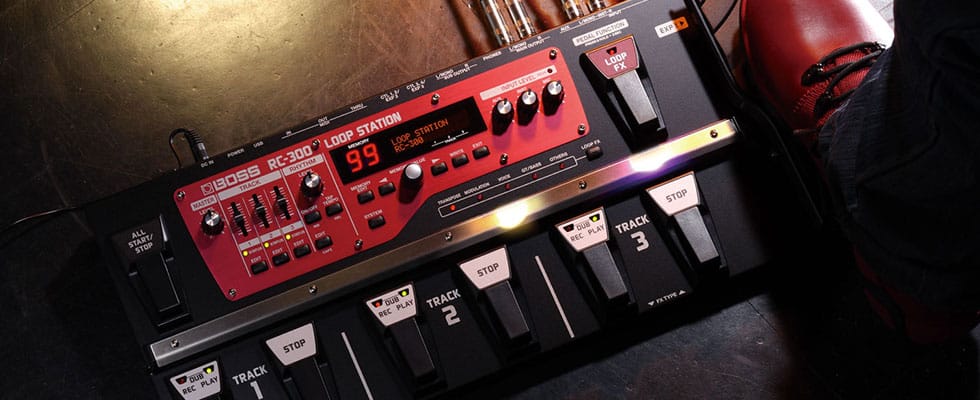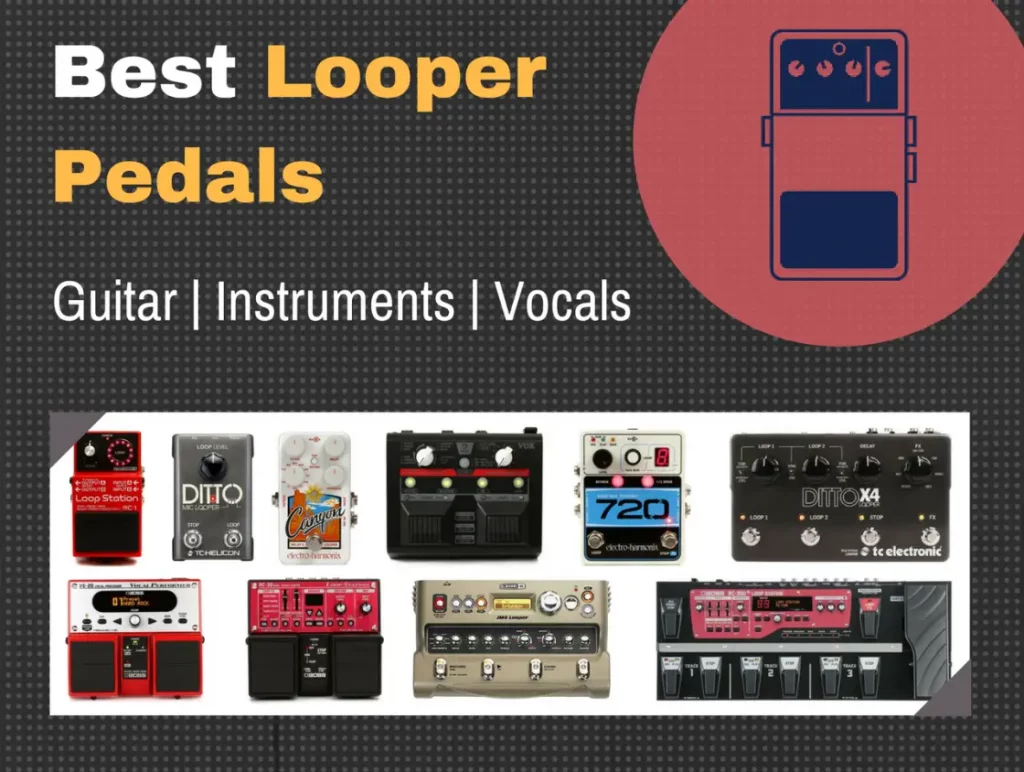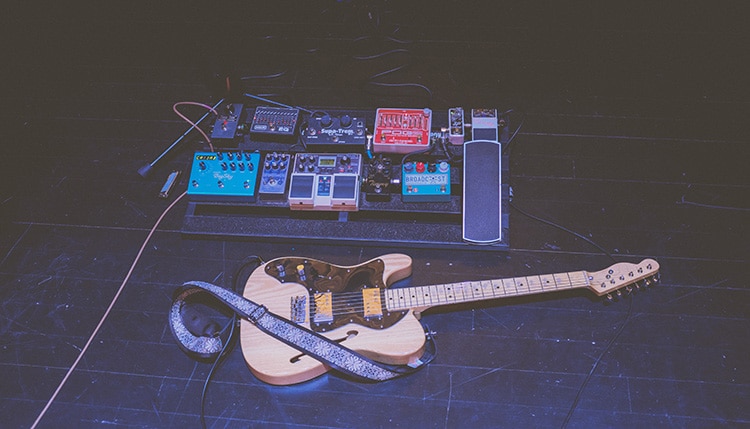Are you an aspiring guitarist looking to take your music to the next level? If so, then you definitely need to consider investing in a guitar loop pedal. This magical device allows you to record and loop musical phrases, giving you the ability to play multiple parts simultaneously and create intricate layers of sound. But with so many options available in the market, how do you choose the best guitar loop pedal that suits your needs? In this ultimate guide, we will explore the key factors to consider when buying a guitar loop pedal, helping you make an informed decision and unlock a world of endless creativity.
Overview of Guitar Loop Pedals
What is a guitar loop pedal?
A guitar loop pedal, also known as a looper pedal, is a compact device that allows guitarists to record and layer multiple tracks of music in real-time. It essentially functions as a digital recorder, capturing and playing back audio loops that can be used as a backing track or to create layered arrangements. This versatile tool has gained immense popularity among musicians, offering endless creative possibilities and enhancing the solo performance experience.
How does a guitar loop pedal work?
A guitar loop pedal works by using a combination of recording, playback, and overdubbing functions. When you play a chord progression or a riff on your guitar, the loop pedal records the audio and creates a repeating loop, which serves as the foundation for your composition. As the loop continues to play, you have the option to add additional layers of music by playing over the existing loop. This allows you to build complex arrangements, harmonies, and rhythms, all controlled by the footswitches on the pedal.
Benefits of using a guitar loop pedal
Using a guitar loop pedal offers several benefits for musicians of all levels. Firstly, it allows you to create a full-band sound as a solo performer, enabling you to play lead melodies and rhythm accompaniments simultaneously. This is particularly useful for solo guitarists who want to enhance their live performances or practice sessions. Additionally, loop pedals can serve as a powerful tool for songwriting, allowing you to experiment and develop ideas on the fly. They can also be a valuable practice companion, enabling you to play along with your own recorded loops and improve your technique.
Different types of guitar loop pedals
There are various types of guitar loop pedals available on the market, each offering unique features and functionality to suit different needs. Let’s take a closer look at some of the most common types:
Factors to Consider
Budget
When it comes to choosing a guitar loop pedal, your budget will play a crucial role in determining the options available to you. Entry-level loop pedals tend to be more affordable, making them a suitable choice for beginners or those on a tight budget. On the other hand, high-end loop pedals offer advanced features and greater loop quality, but they come with a higher price tag. It’s important to strike a balance between your budget and the features you require to ensure you make the right choice.
Number of Loop Tracks
The number of loop tracks refers to the maximum number of loops or layers you can create and play simultaneously on the loop pedal. Single loop track pedals allow you to record and play a single loop at a time, which is ideal for simple musical arrangements or basic practice purposes. For more complex compositions or live performances, you may want to consider loop pedals with multiple tracks, such as dual loop track or multi-track loop pedals, which allow for greater versatility and layering options.
Loop Length
Loop length is another crucial factor to consider. The loop length determines how much time you have to record and build your loops before they start looping back to the beginning. If you primarily create short musical phrases or loops, a pedal with a shorter loop length may suffice. However, if you prefer longer compositions or want more freedom for improvisation, it’s beneficial to opt for a loop pedal with a longer loop length.
Loop Quality
Loop quality refers to the fidelity and clarity of the loops created by the pedal. Higher-quality loop pedals offer seamless and natural-sounding loops that closely match the original audio. On the other hand, lower-quality loopers may introduce noise or degrade the sound quality over time, especially with multiple overdubs. It’s important to choose a loop pedal that provides high-quality looping to ensure your compositions sound professional and polished.
Looper Controls
The controls on a loop pedal determine how easy it is to operate and navigate through different functions. Simple control pedals typically offer basic functions such as record, play, and overdub, making them beginner-friendly and straightforward. More versatile control pedals may have additional features such as reverse, half-speed, or fade-out, allowing for more creative possibilities. Advanced control pedals often come with a plethora of customizable settings, allowing you to fine-tune your loops and create complex arrangements.
Ease of Use
The ease of use is an important consideration, especially if you’re new to using loop pedals. Look for pedals with an intuitive interface and user-friendly design that make it easy to navigate through different functions and control your loops effectively. Some loop pedals feature a clear display that shows the loop status, recording time, and other relevant information, making it easier to keep track of your loops in real-time. A pedal that is easy to use will enhance your overall experience and prevent frustration during your performances or practice sessions.
Portability
Portability is another factor worth considering, particularly if you plan to use your loop pedal for live performances or on-the-go. Compact and lightweight loop pedals are more convenient to transport and fit well on pedalboards, ensuring easy integration into your setup. Some loop pedals also offer battery-powered options, allowing you to use them without relying on an external power source. Considering your specific needs and mobility requirements will help you choose a pedal that suits your lifestyle and performance preferences.
Durability
Durability is an essential aspect to evaluate, especially if you’re an active gigging musician or anticipate heavy usage of your loop pedal. Look for pedals that are built with high-quality materials and have a sturdy construction to withstand the demands of live performances and frequent transportation. Reading product reviews and considering reputable brands known for producing reliable and durable loop pedals will help you make an informed decision.
Power Options
Consider the power options available for the loop pedal you are considering. Most loop pedals can be powered via an AC adapter, which provides a consistent power supply. However, it’s beneficial to choose a loop pedal that offers multiple power options, such as the ability to use batteries or USB power. This provides flexibility in different settings and ensures that you can use your pedal even when AC power is not readily available.
Additional Features
Beyond the basic looping functions, many loop pedals offer additional features that can enhance your musical experience. These features may include built-in effects like reverb or delay, allowing you to add depth and character to your loops. Expression pedal input allows for real-time control of various parameters, providing more expressiveness and dynamic possibilities. MIDI connectivity enables integration with other MIDI-capable devices, opening up a world of creative opportunities. Memory presets allow you to save and recall your favorite loop settings, streamlining your live performances. It’s worth considering these additional features and deciding which ones are important to you in order to fully unleash your creativity and adaptability.
Types of Guitar Loop Pedals
Single Pedal Loopers
Single pedal loopers are the most basic type of loop pedals available. They typically offer one loop track and basic functionality, including record, play, and overdub functions. These loopers are often compact in size and easy to use, making them an ideal choice for beginners or those looking for a straightforward looping experience. Single pedal loopers are affordable and provide a solid foundation for honing your looping skills.
Multi-Track Loopers
Multi-track loopers offer the ability to record and play multiple loop tracks simultaneously. They provide a higher level of versatility, allowing you to create complex musical arrangements with separate loops for rhythm, lead, and other parts. Multi-track loopers often come with more advanced features, such as independent track volume control, loop synchronization, and the ability to switch between different parts of your composition on the fly. These loopers are suitable for intermediate to advanced users and musicians who require more flexibility in their performances or compositions.
Desktop Loopers
Desktop loopers are designed to be placed on a tabletop or studio desk, making them more suitable for studio recording or home use. They often offer additional features beyond looping, such as built-in effects, mixing capabilities, and audio routing options. Desktop loopers usually have a larger footprint and more extensive controls and connectivity options than their pedal-based counterparts. If you prioritize a versatile studio tool that can handle complex recordings and incorporate loops into your music production, a desktop looper might be the right choice for you.
Keyboard Loopers
Keyboard loopers, as the name suggests, are loop pedals specifically designed for keyboards and synthesizers. These loopers typically have stereo inputs and outputs to accommodate the unique needs of keyboard players. They often have features tailored for the integration of MIDI instruments and control, allowing for seamless looping and synchronization with MIDI-capable devices. If you’re a keyboardist or engage in live electronic music production, a keyboard looper will provide the necessary functionalities and connectivity for your specific needs.
Footswitch Loopers
Footswitch loopers are designed to be controlled primarily with your feet, allowing for hands-free operation. These loopers typically have a compact form factor and come with footswitches that control various looping functions, such as record, play, overdub, and stop. Footswitch loopers are ideal for live performances, enabling you to control your loops without interrupting your playing. They are commonly used by solo performers who need maximum control and convenience while on stage.
Portable Loop Stations
Portable loop stations offer the perfect balance between functionality and portability. These loop pedals are compact and lightweight, allowing for easy transportation and integration into your pedalboard setup. They often provide a combination of traditional looping functions and additional features, such as built-in effects, rhythm patterns, or USB audio interfaces. Portable loop stations are suitable for musicians who require a versatile and reliable looping tool that can be easily carried to gigs, rehearsals, or jam sessions.
Budget Considerations
When it comes to budget considerations for a guitar loop pedal, it’s important to find a balance between value and affordability. Here are the three main categories of loop pedals based on price range:
Entry-level Loop Pedals
Entry-level loop pedals are the most budget-friendly options available. These pedals are often simple and straightforward but offer the basic looping functions required for beginners or those on a tight budget. While they may lack some advanced features and customization options found in higher-priced models, entry-level loop pedals are a great starting point for getting familiar with looping technology without breaking the bank.
Mid-range Loop Pedals
Mid-range loop pedals offer a balance between affordability and enhanced features/functionality. These pedals often provide more versatility and control compared to entry-level options. They typically offer a combination of basic and advanced looping functions, making them suitable for intermediate players or musicians who require a wider range of creative possibilities. Mid-range loop pedals can be seen as a worthwhile investment for those seeking improved looping capabilities without venturing into the high-end market.
High-end Loop Pedals
High-end loop pedals are the top-of-the-line options available, offering advanced features, superior loop quality, and extensive customization options. They are often constructed with premium materials, ensuring durability and reliability. High-end loop pedals cater to professional musicians, advanced users, or those who demand the highest level of looping precision and performance. While they come with a higher price tag, these pedals provide unparalleled looping capabilities and audio fidelity for those seeking the best of the best.
Number of Loop Tracks
The number of loop tracks available on a loop pedal determines how many separate loops or layers you can create and play simultaneously. Different loop pedals offer varying numbers of tracks, commonly falling into three categories:
Single Loop Track Pedals
Single loop track pedals allow you to create and play only one loop at a time. While this type of pedal may seem limiting in terms of layering options, it can still be highly useful for basic practice sessions, songwriting, or creating simple musical arrangements. Single loop track pedals are often user-friendly and affordable, making them ideal for beginners or those who primarily need looping for basic purposes.
Dual Loop Track Pedals
Dual loop track pedals offer the ability to create and play two separate loops simultaneously. This opens up more possibilities for layering different parts or harmonies in your compositions. Dual loop track pedals often come with additional features, such as independent volume control for each loop track, loop synchronization, or the ability to switch between loops seamlessly. These pedals are suitable for intermediate users or musicians who require more flexibility in their looping capabilities.
Multi-Track Loop Pedals
Multi-track loop pedals are designed to handle multiple loops or layers of audio simultaneously. They typically offer three or more loop tracks and provide the most extensive layering capabilities. Multi-track loop pedals often come with advanced features, such as independent track volume control, tempo synchronization, and the ability to mix and pan each loop track separately. These pedals cater to advanced users, professional musicians, or those who require maximum control and versatility in their looping compositions. With multi-track loop pedals, you can create intricate arrangements and achieve a full-band sound as a solo performer.
Loop Length
Loop length refers to the maximum duration of a loop that can be recorded and played back on a loop pedal. Different loop pedals offer various loop length options, allowing you to choose the duration that suits your needs:
Short Loop Length
Short loop length typically refers to loops that are a few seconds long. This is suitable for creating quick musical phrases, short motifs, or rhythm patterns. Short loop length is beneficial for musicians who prefer to work with shorter musical ideas or require faster, repeating passages in their compositions. While limited in duration, short loops can be repetitive and provide a solid foundation for building more complex arrangements.
Medium Loop Length
Medium loop length generally ranges from a few seconds up to a minute or two. This allows for more extended musical phrases, complete chord progressions, or melodic ideas with greater complexity. Medium loop length provides a good balance between looping possibilities and the need for longer musical ideas. It offers more freedom for improvisation and experimentation while keeping the loop manageable and concise.
Long Loop Length
Long loop length refers to loops that can extend beyond a few minutes or even up to several hours. These loop pedals are suitable for musicians who require the ability to create extensive, evolving compositions or perform live improvisations. Long loop length provides ample time to build complex arrangements and explore different musical ideas. It allows for extended solos, layered textures, and intricate loops that can captivate listeners and enhance your musical expression.
Loop Quality
Loop quality is an important consideration for musicians who value high-fidelity sound and seamless looping. Different loop pedals offer varying loop quality options based on their internal processing and audio fidelity. Here are some aspects to consider:
High-Quality Looping
High-quality looping refers to loop pedals that offer pristine audio reproduction, ensuring that your loops closely match the original sound source. These loopers use high-resolution audio processing, resulting in loops with minimal degradation or noise. High-quality looping is essential for achieving professional-sounding compositions and maintaining the integrity of the original audio. If sound quality is a top priority for you, investing in a loop pedal that offers high-quality looping capabilities is recommended.
Buffered Looping
Buffered looping is a feature found in some loop pedals that prevent degradation of the audio signal over time. When using traditional (non-buffered) loop pedals, each overdub degrades the sound quality of the previous layers due to repeated conversions from analog to digital and vice versa. Buffered looping solves this problem by buffering the original loop and subsequent overdubs, resulting in cleaner and more transparent loops. Buffered looping enhances the overall sound quality and ensures your loops remain clear and distinct.
Transparent Looping
Transparent looping is another element to consider when evaluating loop quality. Transparent looping refers to loopers that seamlessly integrate the recorded loops into your playing without any audible interruptions or glitches. Some loop pedals with lower loop quality may introduce brief pauses or artifacts when switching between looping functions or overdubbing. Transparent looping ensures smooth transitions and a fluid playing experience, enabling you to create seamless compositions without any noticeable gaps or discrepancies.
Looper Controls
The controls on a loop pedal determine how easy it is to operate, navigate through different functions, and adjust various parameters. Different loop pedals offer varying levels of control, ranging from simple to versatile to advanced. Let’s explore the different types of looper controls:
Simple Controls
Loop pedals with simple controls are often user-friendly and beginner-friendly. They typically include basic functionalities such as record, play, overdub, and stop. The design and layout of these pedals are straightforward, making it easy to navigate through different functions and control your loops effectively. Simple control loop pedals are ideal for those who prefer a streamlined and fuss-free looping experience without the need for complex customization or advanced features.
Versatile Controls
Loop pedals with versatile controls offer a broader range of functionalities beyond the basic looping functions. These pedals often include additional features such as reverse, half-speed, fade-out, or loop synchronization. Versatile controls allow for more creative possibilities, enabling you to experiment with different audio effects and manipulate your loops in unique ways. They provide a level of customization and sonic exploration, making the looping experience more dynamic and engaging.
Advanced Controls
Loop pedals with advanced controls offer the most comprehensive range of features and customization options. These pedals often come equipped with extensive controls, including adjustable parameters for loop levels, tempo, pitch, or effects. Advanced controls provide maximum flexibility and fine-tuning capabilities, allowing you to create complex arrangements and tailor your loops to your exact specifications. These pedals are typically used by professional musicians, advanced users, or those who demand a high level of control and precision in their looping compositions.
Ease of Use
Beyond functionality and features, the ease of use is an important aspect to consider when choosing a guitar loop pedal. An intuitive interface, user-friendly design, and clear display can significantly enhance your overall looping experience. Here are some factors to evaluate:
Intuitive Interface
Loop pedals with an intuitive interface are designed to be easy to understand and operate. The layout of the controls is logical and straightforward, allowing you to navigate through different functions without confusion. An intuitive interface ensures that you can focus on your music rather than getting caught up in complex menu systems or convoluted control schemes. When trying out loop pedals, pay attention to how quickly you can grasp the basic operations and find the functions you need.
User-Friendly Design
A user-friendly design encompasses not only the layout of the controls but also the physical characteristics of the loop pedal. Look for a pedal that is ergonomically designed and comfortable to operate, especially if you plan on using it for long periods. Consider factors such as button size, spacing, and responsiveness to ensure smooth operation and ease of use. Additionally, the pedal should feel solid and stable under your foot, ensuring that you can trigger functions accurately during live performances or practice sessions.
Clear Display
A clear display on a loop pedal provides vital information about the status of your loops, recording time, and other relevant details. It allows you to monitor the progress of your loops in real-time and make adjustments as needed. A clear and well-designed display ensures that you can easily keep track of your looping sessions, preventing confusion or mistakes during live performances. Look for loop pedals with displays that offer clear visibility, adequate size, and appropriate contrast to optimize your user experience.
Additional Features
While the basic looping functions are the core of a loop pedal, many pedals offer additional features that can enhance your musical experience or provide added versatility. Depending on your specific needs and preferences, you may want to consider the following additional features:
Built-In Effects
Some loop pedals come with built-in effects, such as reverb, delay, modulation, or distortion. These effects can add depth, character, and ambiance to your loops, enriching your compositions or performances. Built-in effects allow you to explore different sonic landscapes and create unique textures without the need for additional pedals or effects units. If you desire the convenience of having effects readily available within your loop pedal, consider models that offer a wide range of built-in effects.
Expression Pedal Input
Expression pedal input allows you to connect an expression pedal to the loop pedal and control various parameters in real-time. This enables you to add dynamic changes, such as volume swells, filter sweeps, or modulation control, while your loops are playing. The expression pedal input expands your creative possibilities and provides more expressiveness, allowing you to shape and manipulate the sound of your loops on-the-fly.
MIDI Connectivity
Loop pedals with MIDI connectivity provide the ability to sync with other MIDI-capable devices, such as keyboards, drum machines, or software applications. This allows for seamless integration of your loops with other musical elements, enabling you to create more intricate and synchronized compositions. MIDI connectivity opens up a world of creative possibilities, providing access to a wide range of sounds and control options beyond just the loop pedal itself.
Memory Presets
Memory presets allow you to save and recall your favorite loop settings, making it easy to access specific loop compositions or arrangements without manually recreating them each time. This feature is particularly useful for live performers who need to switch between different songs or sections of their performance seamlessly. Memory presets streamline your looping workflow and ensure consistency in your live performances or studio recordings.
Undo/Redo Function
The undo/redo function allows you to remove or restore the most recent layers or overdubs in your loops. This function is valuable when you make a mistake during the recording process or want to experiment with different parts of your looping composition. The undo/redo function ensures flexibility and provides the opportunity to refine your loops and make adjustments on-the-fly.
Stereo Input/Output
Loop pedals with stereo input/output capability offer a wide stereo field, making them ideal for creating spacious and immersive looping arrangements. Stereo input allows you to capture the audio signals from multiple sources, such as dual guitars or stereo keyboards, while stereo output provides a full and immersive sound when played through stereo amplification or headphones. If you prioritize spatial and detailed looping compositions, a pedal with stereo input/output will enhance your overall sound quality and perception.
Tap Tempo
Tap tempo functionality allows you to set the tempo of your loops by tapping a button or footswitch in real-time. This ensures precise synchronization with other rhythm-based elements in your music, such as a drum machine or click track. Tap tempo eliminates the need for manual adjustment of the loop tempo, providing convenience and keeping your compositions locked into the desired rhythm. If timing and synchronization are critical in your looping compositions, look for a loop pedal with tap tempo capability.
Built-In Metronome
A built-in metronome can be a valuable tool, especially for practice and keeping your timing steady. Loop pedals with a built-in metronome provide a reference click track that helps you stay on beat while recording or playing loops. Some loop pedals allow you to adjust the metronome tempo and customize the sound of the click, ensuring that it suits your specific needs and preferences. If you value consistent timing and want to improve your sense of rhythm, consider a loop pedal with a built-in metronome.
USB Audio Interface
Loop pedals with USB audio interface capability allow you to connect directly to a computer or recording device via USB. This provides a seamless connection for recording loops directly into your digital audio workstation (DAW) or capturing high-quality audio for live streaming or online performances. USB audio interface functionality eliminates the need for additional audio interfaces or cables, streamlining your recording or streaming setup and enhancing the versatility of your loop pedal.
Software Integration
Certain loop pedals offer software integration options, allowing you to connect to specific software applications or DAWs. This opens up a host of advanced features and additional control options, such as loop management, automation, synchronization, or parameter editing. Software integration provides a deeper level of control and expands the creative possibilities, making it an appealing option for musicians who are heavily involved in computer-based music production or performance.
In conclusion, choosing the best guitar loop pedal involves considering various factors such as your budget, the number of loop tracks you require, the desired loop length, loop quality, looper controls, ease of use, portability, durability, power options, and additional features. By taking the time to evaluate these factors and determine your specific needs, you can find the perfect guitar loop pedal that unlocks your creativity, enhances your performances, and takes your music to new heights. Happy looping!











